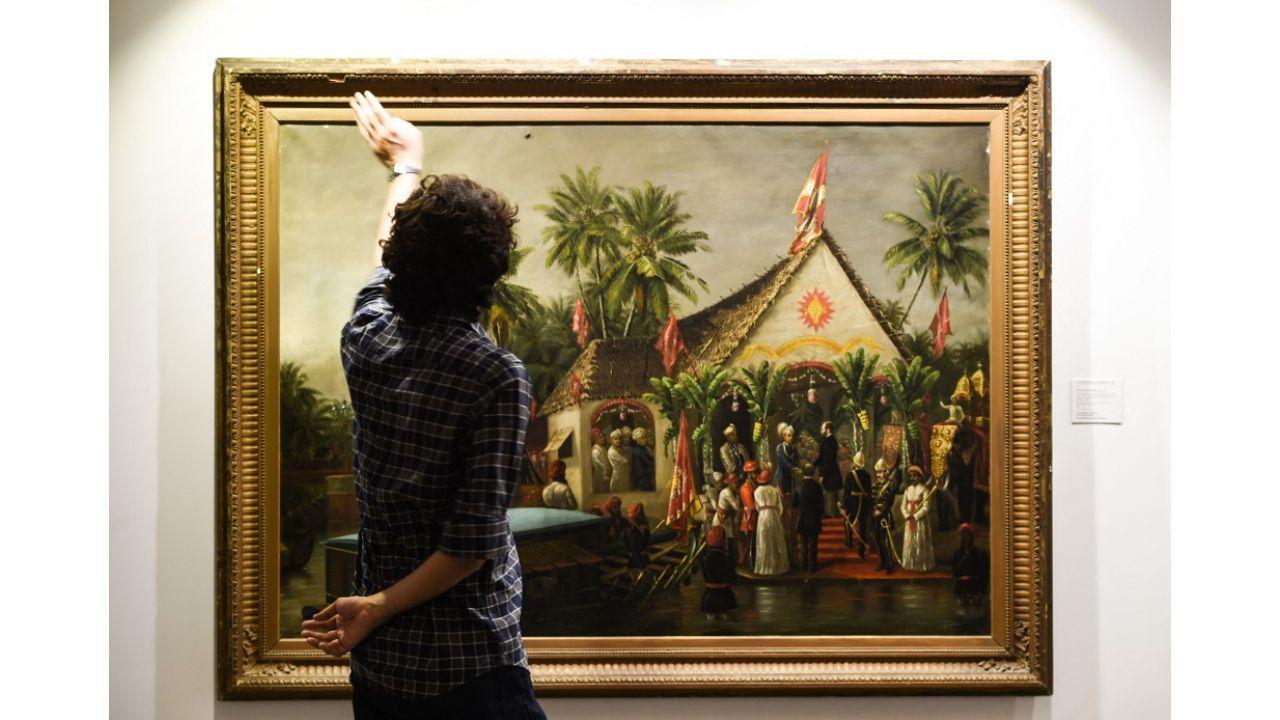The artist from Travancore—regarded as one of the greatest Indian painters of all time and born on this day in 1848 had a printing press in Mumbai once. This, and other episodes from his life and work

April 29 marks the 173rd birth anniversary of artist Raja Ravi Varma. A staff member checks the frame of a Raja Ravi Varma painting at a Mumbai auction house in 2019. Photo: AFP/Indranil Mukherjee
Regarded as one of India’s most revered painters, Raja Ravi Varma’s work is known to be a combination of European art and Indian aesthetics. Having started painting in Travancore, he went on to travel across India, and even made a brief stop in Mumbai.
Born in the Kilimanoor Palace, which was a part of the former princely state of Travancore in Kerala, the artist was patronised by Ayilyam Thirunal, who was to become the next Maharaja of Travancore during his time. From there, Varma went on to get further training and become one of the most celebrated painters in India.
Here is a selection of things to know about the painter on his 173rd birth anniversary:
The royal connection
At 18, Raja Ravi Varma was married to 12-year-old Bhageerathi Bayi, from the royal house of Mavelikkara, which was a branch of the Royal House of Travancore. Bhageerathi’s elder sisters, who were adopted by the royal family to carry on the lineage, couldn’t produce female heirs to carry on the matrilineal system of succession. So, Bhageerathi and Raja Ravi Varma’s eldest two of three daughters – Mahaprabha Amma and Uma Amma were given the privilege.
It was through this system that Mahaprabha’s eldest daughter Lakshmi Bayi and Uma’s eldest daughter Parvati Bayi, who were 5 and 4 years respectively at the time, were adopted by the royal family. Being the first among the two to bear a child in 1912, a day after she turned 16, Parvati gave birth to Chithira Thirunal, who was the last ruling Maharaja of Travancore. Rama Varma VII, the current titular Maharaja of Travancore is the son of Chithira Thirunal’s sister Lakshmi Bayi. This also means that the current royal family of Travancore has descended from Raja Ravi Varma.
From Travancore to Mumbai
Known for making lithographs of his paintings to make it more accessible to the people beyond his canvases, Raja Ravi Varma opened a lithographic printing press in Mumbai’s Ghatkopar neighbourhood in 1894. However, he shifted it to Malavli near Lonavala five years later. The press printed his paintings of scenes from the Mahabharata, Ramayana and the Puranas depicting Hindu gods and goddesses. The press, which was really popular at the time, was managed by his brother Raja Varma.
However, it fell into losses and was sold to the press’s German technician Fritz Schleicher, who ran it successfully and expanded the scope of work beyond Raja Ravi Varma’s prints to include advertisements. The factory burned down in a fire in 1972. Varma’s link to the city extended to the next generation. His younger son Rama Varma studied at the JJ School of Arts in Fort.
The art and the artist
While Raja Ravi Varma is said to have been patronised by Ayilyam Thirunal, it is believed that his first teacher was his uncle Raja Raja Varma, who saw his potential early on. He later went on to study painting in Madurai before receiving formal training from two other known teachers. Varma was schooled by Ramaswamy Naidu and Dutch portrait artist Theodore Jenson in water painting and oil painting respectively. According to several reports, Varma is believed to have painted over 7,000 paintings before he died in 1906 at the age of 58 and is said to be the first Indian to use oil paints.
In the land of cinema
Director J Sasikumar from Kerala made a film about the artist in 1990 called ‘Raja Ravi Varma’. He is not the only director from Kerala to have made a film on the painter. In 2010, director Lenin Rajendran made ‘Makaramanju’ (The Mist of Capricorn), a romantic drama film about a certain moment in the painter’s life. The role of Raja Ravi Varma was played by Indian actor and cinematographer Santosh Sivan. In Bollywood, director Ketan Mehta made ‘Rang Rasiya’, an erotic drama film on the painter in two languages – Hindi and English. It was called ‘Colours of Passion’ in English. Indian actor Randeep Hooda played the lead role.
Accolades to Mercury and back
With the kind of influence Raja Ravi Varma had on Indian art, it is only fitting that he was honoured in more ways than one. Two years before he passed away, Varma received the Kaisar-i-Hind gold medal from Viceroy Lord Curzon in 1904 for his contribution to the field of art. The Kerala government also awards the Raja Ravi Varma Puraskaram to people who display excellence in the field of art and culture. While many institutions are named after him on Earth, in 2013, a crater on the planet Mercury was also named after him by the International Astronomical Union to honour his work.
 Subscribe today by clicking the link and stay updated with the latest news!" Click here!
Subscribe today by clicking the link and stay updated with the latest news!" Click here!









